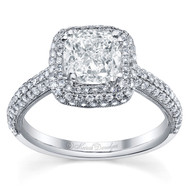Types of Pavé and Their Differences
Posted by Koorosh Daneshgar on Dec 30th 2017
What is pavé and how does it differ from other setting styles?
What is pavé?
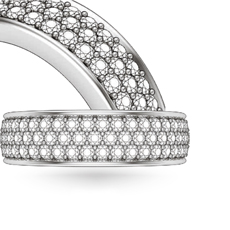
Traditionally a pavé ring features multiple rows of diamonds that are held in place by shared small prongs that leave little-to-no gap between stones giving the appearance that the jewelry is “paved” with stones. However, recently in jewelry, the definition of pavé has been broadened to describe any jewelry that incorporates melee stones (any stone that is smaller than .20ct) that share prongs.
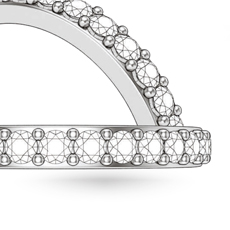
What are the benefits and drawbacks of pavé setting?
Ask anyone who sees pavé style rings, they will tell you they are very beautiful. As a result of the number of diamonds set so close together, pavé set rings have a sparkle that is almost unparalleled by other setting styles. Their small, delicate prongs cover less of the stone and allows an increased visibility and more light entering and leaving the stone. Pavé setting is ideal for guests who want a dainty, feminine design with a beautiful presence and sparkle.
Unfortunately, the delicateness of the design, is also the downfall of pavé. This style is notorious for having the highest likelihood of losing stones. Their dainty design, coupled with their small delicate prongs make for a fragile design resulting in a higher risk for stone security. As always, it is recommended to take care of your rings, and have them regularly inspected every 6 months by a jewelry professional.
Is there a price difference for a pavé style?
There are advantages and disadvantages to the cost of pavé settings. Pavé settings consist of a myriad of smaller stones. These smaller stones tend to cost less because they are smaller. However, due to the number of stones and the cost of labor to have a jeweler set that many stones, the price tends to balance itself out. It is very difficult to say that any style is or is not more expensive than another style; however, a good factor to consider when looking at the cost of the ring is the labor that went into making it.
What are other setting styles and how do they compare?
There are as many setting styles for jewelry as there are stars in the sky. Each one has its benefits and drawbacks, however, on here I will just discuss the most prominent styles of mounting.
Prong- The most prominent style being used in jewelry is prong setting. Like the name suggests, prong set consists of metal prongs holding on to a stone. However, this can have a variety of variations including shared-prong and split-prong. This style sees 2-4 prongs holding each stone in place. Those prongs can hold each individual stone, the prong can be split down the middle to hold two individual stones (split-prong) or each prong could be shared between two or more stones (shared-prong)
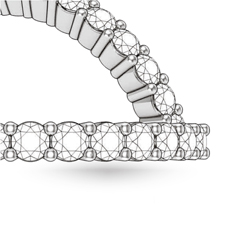
> Shared Prongs
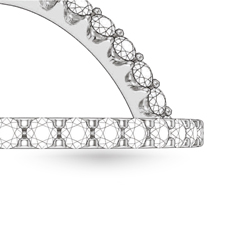
> Scalloped*
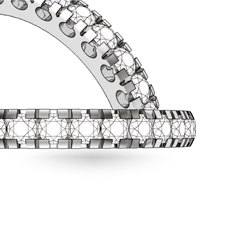 Split-Prong
(Fish-tail)
Split-Prong
(Fish-tail)
Prong setting is one of the settings with the best combinations of security and appearance. Prongs do allow a decent amount of light to reach the diamond ensuring a high level of brilliance. Shared prongs can pose a risk as the breaking of one prong can put more than one stone at risk. However, because the prongs are thicker than pavé setting, it is sturdier and is usually as preferred alternative to pavé.
*Scalloping is just an aesthetic design choice that allows more light to hit the stone from the side, increasing brilliance. Therefore scalloping has minimal impact on the security of stones.
Channel- Another popular style in modern and contemporary jewelry is channel setting. Channel setting sees rows of stones set into a channel in the metal with metal edges holding the stones in place.

Channel settings are great in terms of security, being one of the most secure settings available for multiple small stones in jewelry. The downside revolving around channel setting is the amount of stone that is covered up by metal. Because the stones are set into metal, less light I able to reach the stones, decreasing the amount of sparkle. Channel setting is a setting style that is almost exclusively reserved for round, baguette, emerald, ascher, and princess cut.
Bezel- Bezel setting is a very minimalistic setting where a diamond is set into metal (like a channel setting) but the stones are surrounded by metal.
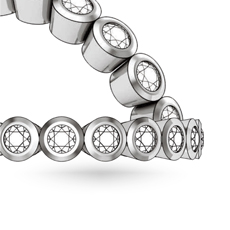
Bezel settings have an almost identical list of pro’s and con’s as channel setting. Their being surrounded by metal does diminish the sparkle from the stones while simultaneously increasing the security of the stones. While almost any stone can be bezel setting, it does increase the likelihood of chipping, cracking or breaking more fragile stone types and shapes.
Bar Set- Bar setting is a style of setting that sandwiches a stone in between two bars of metal (similar in design to channel setting). Bar setting is a type of tension setting and may be referred to as this as well.
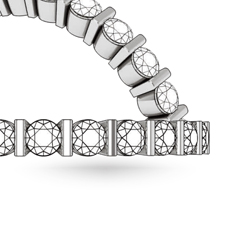
Bar setting is a very similar setting in design, to channel setting leaving it susceptible to the same benefits and drawbacks. However, bar setting is not typically as sturdy of a setting as channel setting. This is because the individual bars are more susceptible to shifting, wear or breaking putting two stones at risk. Bar setting rarely done on stones that are not symmetrical or with straight edges, and are therefore most frequently used on round, baguette, and princess cut.
Bead Set- Bead setting gets its name because the prongs holding the stones in place are small beads of metal. To preserve the prongs and maintain security, the stones are set into the metal like a channel setting with a thin edge. Bead setting is most frequently used on rings that require Milgrain detailing, which works very well on the edge of metal.
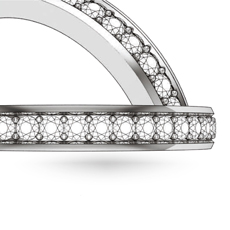
Bead setting is the most similar in style to pavé setting in design because the prongs are of the same build. This means bead setting is prone to stones becoming loose or falling out if the prongs shift or break. However, the edge of metal around the stones helps protect the prongs holding the stones in place. This, unfortunately, does take light away from the diamond making it brilliant although not as brilliant as pave.
Gypsy/Flush/Hammer- Gypsy/Flush/Hammer setting is a unique and rarely used setting style that sets a diamond flush with the metal surrounding it with only thin lips of metal holding stones in place.
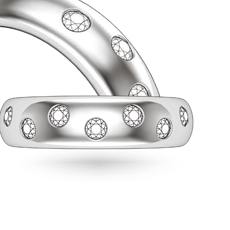
Gyspy/Flush/Hammer setting is a very temperamental setting that is visually appealing but very prone to stone loss because of the minimal metal used to hold the stones in place. Gypsy/Flush/Hammer setting is almost exclusively used to set round brilliant cut stones.
What type of setting will look good on me or my partner?
This is a fair question; however, it is a question that is impossible to answer. Like choosing clothing, cars or shoes, it is best to try rings on and see if you like the way they look. So, get out there and try on rings, see what style appeals most to you and what you think looks best on your finger.
Why should we come to you to design my ring?
We involve you in every step of the process. We will first sit down with you and go over any concerns you have and any specific design elements you want the ring to have. Once we have established exactly what you want the ring to look like, we will proceed with the design process. Once you see this design, if you want to make any changes, or if you have any questions or concerns we will be happy to address them for you. Our role is to help you create the perfect ring and that means we will listen to you and make sure that your ring is truly one of a kind.
We'll help you to design your dream engagement ring without stress and spending countless hours searching for your perfect ring. All you need to do is click on "Free Consultation" to get started.
By: Koorosh Daneshgar CEO/Design Chief
Email: Koorosh@WeddingBandscompany.com
Phone: 312-920-0726
Business Text Message Line:312-785-8333

